
The cello ( CHEL-oh), or violoncello ( VY-ə-lən-CHEL-oh, Italian pronunciation: [vjolonˈtʃɛllo]), is a bowed (sometimes plucked and occasionally hit) string instrument of the violin family. Its four strings are usually tuned in perfect fifths: from low to high, C2, G2, D3 and A3. The viola's four strings are each an octave higher. Music for the cello is generally written in the bass clef, with tenor clef, and treble clef used for higher-range passages.

The double bass, also known simply as the bass, amongst other names, is the largest and, therefore, lowest-pitched chordophone in the modern symphony orchestra. Similar in structure to the cello, it has four, although occasionally five, strings.

The guitar is a fretted musical instrument that typically has six strings. It is usually held flat against the player's body and played by strumming or plucking the strings with the dominant hand, while simultaneously pressing selected strings against frets with the fingers of the opposite hand. A plectrum or individual finger picks may also be used to strike the strings. The sound of the guitar is projected either acoustically, by means of a resonant chamber on the instrument, or amplified by an electronic pickup and an amplifier.

A mandolin is a stringed musical instrument in the lute family and is generally plucked with a pick. It most commonly has four courses of doubled strings tuned in unison, thus giving a total of eight strings. A variety of string types are used, with steel strings being the most common and usually the least expensive. The courses are typically tuned in an interval of perfect fifths, with the same tuning as a violin. Also, like the violin, it is the soprano member of a family that includes the mandola, octave mandolin, mandocello and mandobass.
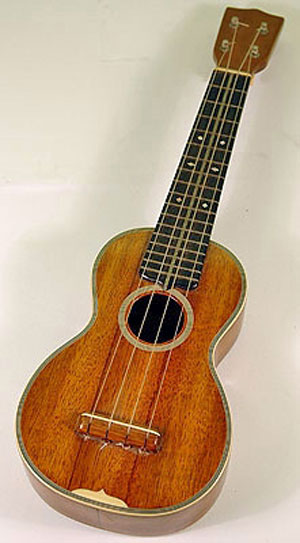
The ukulele, also called a uke, is a member of the lute family of instruments of Portuguese origin and popularized in Hawaii. It generally employs four nylon strings.
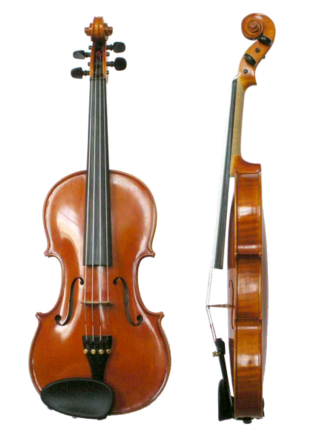
The violin, sometimes known as a fiddle, is a wooden chordophone in the violin family. Most violins have a hollow wooden body. It is the smallest and thus highest-pitched instrument (soprano) in the family in regular use. The violin typically has four strings, usually tuned in perfect fifths with notes G3, D4, A4, E5, and is most commonly played by drawing a bow across its strings. It can also be played by plucking the strings with the fingers (pizzicato) and, in specialized cases, by striking the strings with the wooden side of the bow.

The viola ( vee-OH-lə, Italian: [ˈvjɔːla, viˈɔːla]) is a string instrument that is bowed, plucked, or played with varying techniques. Slightly larger than a violin, it has a lower and deeper sound. Since the 18th century, it has been the middle or alto voice of the violin family, between the violin (which is tuned a perfect fifth above) and the cello (which is tuned an octave below). The strings from low to high are typically tuned to C3, G3, D4, and A4.

The viol, viola da gamba, or informally gamba, is any one of a family of bowed, fretted, and stringed instruments with hollow wooden bodies and pegboxes where the tension on the strings can be increased or decreased to adjust the pitch of each of the strings. Frets on the viol are usually made of gut, tied on the fingerboard around the instrument's neck, to enable the performer to stop the strings more cleanly. Frets improve consistency of intonation and lend the stopped notes a tone that better matches the open strings. Viols first appeared in Spain in the mid-to-late 15th century, and were most popular in the Renaissance and Baroque (1600–1750) periods. Early ancestors include the Arabic rebab and the medieval European vielle, but later, more direct possible ancestors include the Venetian viole and the 15th- and 16th-century Spanish vihuela, a six-course plucked instrument tuned like a lute that looked like but was quite distinct from the four-course guitar.
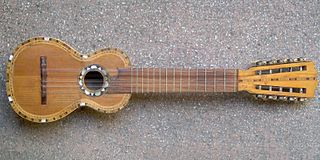
The charango is a small Andean stringed instrument of the lute family, from the Quechua and Aymara populations in the territory of the Altiplano in post-Colonial times, after European stringed instruments were introduced by the Spanish during colonialization. The instrument is widespread throughout the Andean regions of Bolivia, Peru, Ecuador, northern Chile and northwestern Argentina, where it is a popular musical instrument that exists in many variant forms.
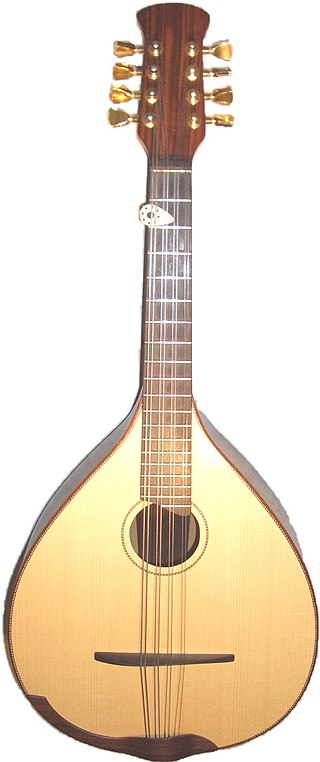
The mandola (US and Canada) or tenor mandola (Ireland and UK) is a fretted, stringed musical instrument. It is to the mandolin what the viola is to the violin: the four double courses of strings tuned in fifths to the same pitches as the viola (C3-G3-D4-A4), a fifth lower than a mandolin. The mandola, though now rarer, is an ancestor of the mandolin. (The word mandolin means little mandola.)
Scordatura is a tuning of a string instrument that is different from the normal, standard tuning. It typically attempts to allow special effects or unusual chords or timbre, or to make certain passages easier to play. It is common to notate the finger position as if played in regular tuning, while the actual pitch resulting is altered. When all the strings are tuned by the same interval up or down, as in the case of the viola in Mozart's Sinfonia Concertante for Violin, Viola and Orchestra, the part is transposed as a whole.

The Appalachian dulcimer is a fretted string instrument of the zither family, typically with three or four strings, originally played in the Appalachian region of the United States. The body extends the length of the fingerboard, and its fretting is generally diatonic.
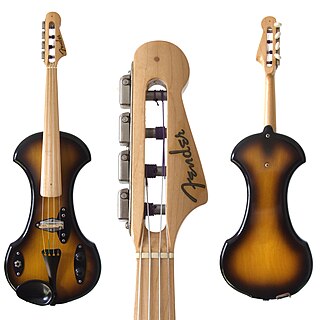
An electric violin is a violin equipped with an electronic output of its sound. The term most properly refers to an instrument intentionally made to be electrified with built-in pickups, usually with a solid body. It can also refer to a violin fitted with an electric pickup of some type, although "amplified violin" or "electro-acoustic violin" are more accurate then.

A tiple, is a plucked typically 12-string chordophone of the guitar family. A tiple player is called a tiplista. The first mention of the tiple comes from musicologist Pablo Minguet e Irol in 1752. Although many variations of the instrument exist, the tiple is mostly associated with Colombia, and is considered the national instrument. The Puerto Rican version characteristically has fewer strings, as do variants from Cuba, Mallorca, and elsewhere among countries of Hispanic origin.

The mandocello is a plucked string instrument of the mandolin family. It is larger than the mandolin, and is the baritone instrument of the mandolin family. Its eight strings are in four paired courses, with the strings in each course tuned in unison. Overall tuning of the courses is in fifths like a mandolin, but beginning on bass C (C2). It can be described as being to the mandolin what the cello is to the violin.
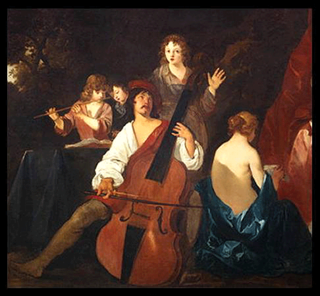
The term violone can refer to several distinct large, bowed musical instruments which belong to either the viol or violin family. The violone is sometimes a fretted instrument, and may have six, five, four, or even only three strings. The violone is also not always a contrabass instrument. In modern parlance, one usually tries to clarify the 'type' of violone by adding a qualifier based on the tuning or on geography, or by using other terms that have a more precise connotation. The term violone may be used correctly to describe many different instruments, yet distinguishing among these types can be difficult, especially for those not familiar with the historical instruments of the viol and violin families and their respective variations in tuning.
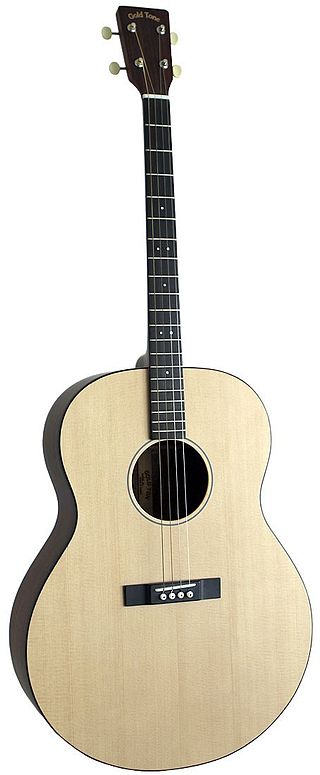
The tenor guitar or four-string guitar is a slightly smaller, four-string relative of the steel-string acoustic guitar or electric guitar. The instrument was initially developed in its acoustic form by Gibson and C.F. Martin so that players of the four-string tenor banjo could double on guitar.
In music, standard tuning refers to the typical tuning of a string instrument. This notion is contrary to that of scordatura, i.e. an alternate tuning designated to modify either the timbre or technical capabilities of the desired instrument.

A tenor violin (or tenor viola) is an instrument with a range between those of the cello and the viola. An earlier development of the evolution of the violin family of instruments, the instrument is not standard in the modern symphony orchestra. Its tuning, typically G2-D3-A3-E4 (an octave below the regular violin) places the range between the cello and viola and thus is sometimes confused with the modern baritone violin which has the same tuning on the standard violin body.

A five-string violin is a variant of violin with an extra string tuned below the violin's usual range. In addition to the G, D, A, and E strings of a standard violin, a five-string violin typically includes a lower C string. Violins with 6 or more strings may add a low F, low B♭, low E♭, or a soprano violin high A.

















